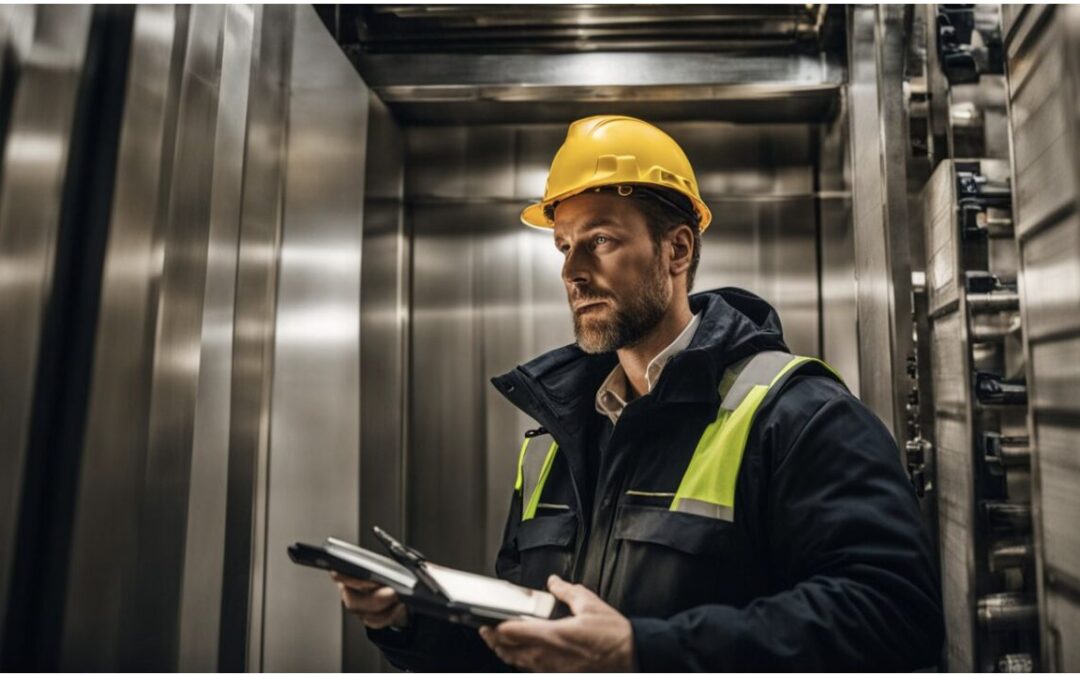Are you looking for ways to cut down on your building’s energy costs? Elevators use about 10% of a building’s electricity. This article will show how elevators with counterweights can save and manage that power better.
The Concept of Lift Energy Storage Technology
Lift energy storage technology turns elevators into power savers. It uses the up and down movement to store energy, helping buildings use less power.
Definition and purpose
Lift Energy Storage Technology (LEST) converts elevators in tall structures into power storage systems. This technology harnesses gravitational energy generated by an elevator’s vertical movement, reserving it for subsequent use.
You can view it as a building’s unique power source. This is more than an energy-saving technique; LEST also regulates energy demand over periods, optimizing power usage.
This method suggests a distributed style of power storage—conceive a situation where each building operates as a diminutive energy production unit. The research documented in “Energy,” Volume 254, Part A, dated September 1, 2022 by Julian David Hunt and his team elaborates how LEST can handle daily to weekly energy oscillations.
This implies buildings reducing their electricity intake from the grid and also augmenting it during prime hours.
LEST operates as a distributed solution for energy storage oscillations from daily to weekly.
Let’s understand the crucial contribution of elevators in managing a building’s power.
Benefits of utilizing counterweights for energy storage
Elevators employ counterweights to counterbalance the car’s weight, a strategy that also harbors the potential for energy storage, contributing toward more power-efficient buildings.
- Cost-efficiency: The cost to incorporate energy storage into elevators ranges from 21 to 128 USD per kWh. This spectrum varies based on building height and could result in significant financial benefits in the long run.
- High capacity: Elevator Energy Storage Technology (LEST) could possess a global capacity of 30 to 300 GWh. Geographies with high-rise buildings are particularly well-suited for this technology.
- Renewable energy compatibility: LEST complements wind and solar power by storing surplus energy for future consumption, enhancing the reliability of these energy sources.
- Environmentally conscious: Leveraging elevator counterweights for storage reduces dependence on fossil fuels, favoring a cleaner environment.
- Effective power management: At peak times, buildings can utilize this stored energy rather than straining the grid further, which eases demand pressures and lowers expenses.
- Reserve during failures: During power failures, the energy stored in elevators can supply emergency power, ensuring critical systems remain operational.
- Promotes sustainability: By implementing this novel storage solution, the buildings become participants in a resource-conserving, sustainable urban development model.
- Financial feasibility: Due to its cost-effectiveness and efficiency in urban high-rises, LEST presents an attractive proposition for facility executives considering long-term capital investments in infrastructure upgrades.
The use of counterweights optimizes the efficiency of existing elevator systems and presents an intelligent method to address the power requirements of buildings in an efficient and environmentally friendly manner.
How Elevators Can Help With Building Power Management
Elevators with counterweights save energy. They give back power during busy times and blackouts.
Using energy from counterweights during peak hours
During high-activity periods, structures are subject to elevated energy requirements. Utilizing counterweight energy consumption and regenerative drive technology, elevators can aid in managing this situation.
They convert the task of vertical human transport into an opportunity for electricity conservation. As lifts descend with a load, they generate energy. This energy is subsequently contributed back to the building’s network.
It serves as a small aid to the building when it’s most needed.
Elevator technology advancements could contribute to energy savings ranging from 20% to 40%.
This translates into lesser strain on auxiliary power supplies during periods of heightened electricity demand. Approximately 10% of a building’s electricity is designated for elevator use.
By capturing energy from descending cars, they reduce their power consumption and also give back during crucial times. Contemplate reducing your building’s overall energy usage by up to 40%.
That is the potential offered by effective counterweight management and current elevators – a more intelligent method to cope with high-demand hours.
Storing energy for use during power outages
Buildings can now use elevators as a smart way to manage power, especially during outages. Elevators with counterweights store energy by lifting heavy containers filled with wet sand or other dense materials.
This method, called LEST, uses autonomous trailers to move these containers up and down. The energy gets saved when the elevator lifts the container. It is then ready to make electricity as the container comes down.
This setup needs empty spaces at both the top and bottom of a building for storing and getting back this energy. So, elevators don’t just move people anymore—they play a big part in keeping lights on without using more power from outside sources during an outage.
Innovations in Elevator Technology for Energy Storage
New elevator tech is changing how buildings save energy. Smart systems and updates make elevators store power, helping the earth and saving money.
Smart elevators utilizing AI to optimize energy usage
Elevators are getting smarter, thanks to AI and machine learning. These smart elevators use advanced technology to cut energy use. They learn from daily patterns and adjust their operations.
For instance, they move to standby mode when not in use. Plus, they have LED lighting and energy regeneration systems that save more power.
Smart elevators also come with IoT sensors for ongoing checks. This means they can spot problems early with predictive maintenance. This helps avoid big repairs later on. And let’s not forget – these elevators listen! Yes, voice commands and facial recognition make them user-friendly while saving energy.
Innovations like AI-powered smart elevators are changing the game for building management by significantly reducing energy consumption.
Next up, we’ll talk about how adding new storage systems can make old elevators into power savers too.
Retrofitting elevators with modern energy storage systems
After exploring how smart elevators use AI to cut down on energy use, we turn our focus to updating old elevators with new energy storage technology. This change is key for buildings looking to be more green and efficient.
Modernizing elevators so they can store renewable energy is a big step forward. It’s like giving an old car a new, fuel-efficient engine.
Older buildings have a unique chance here. They can upgrade their elevators with systems that save and use energy in smarter ways. For instance, energy generated when the elevator goes down can power it back up later.
This system is pretty sharp; it turns what was once wasted into something valuable – electricity! The cost for setting up this kind of storage ranges from 21 to 128 USD per kWh. Given there are over 18 million elevators around the globe often sitting unused, retrofitting them could lead to huge savings and less waste of electricity.
Impact and Future of Elevator Energy Storage
Elevator energy storage stands to change how buildings use power. The road ahead looks bright, with new tech making elevators even smarter and greener.
Potential for reducing building energy consumption
Utilizing elevator energy storage systems allows buildings to achieve their climate and energy goals. Such systems capitalize on counterweights to conserve or create energy. This innovative solution could significantly reduce building energy expenses, considering elevators constitute approximately 5–15% of a building’s total energy consumption.
By incorporating regenerative drive technology, an energy saving of 20% to 40% becomes achievable. Visualize the transformative impact on cities dotted with skyscrapers! The global potential for Lift Energy Storage Technology (LEST) could reach an impressive 300 GWh in city regions.
This method diminishes dependency on conventional power sources and encourages environmentally-friendly building design. It signifies a crucial step towards making cities greener and more efficient.
Building proprietors and facility managers need to consider this, as integrating elevators into your building’s power management system is beneficial not just for the environment but also for cost reduction.
Role of elevator maintenance in ensuring efficient energy storage
Effective elevator maintenance is crucial for energy efficiency. By consistently inspecting elevators, energy storage issues can be detected and rectified prematurely. This contributes to the building’s reduced energy consumption.
Proper elevator upkeep is essential for maximizing the potential of energy storage solutions.
Routine elevator service guarantees that these systems operate efficiently without exceeding necessary power usage. Maintenance teams prioritize the seamless operation of the entire system so buildings can economize on energy costs.
This strategy reduces the building’s energy expenditure and concurrently assists the comprehensive facility management objectives of energy conservation and sustainability.
Predicted advancements in elevator energy storage technology
In the near future, elevator energy storage technology will see big changes. Experts say this tech could help buildings use less power and save money. Also, it might make buildings produce fewer carbon gases that are bad for our air.
This is a big deal because using elevators smarter can really help with managing how much electricity a building uses.
Soon, we might see new rules encouraging tall buildings to share their saved power with the bigger electric system. This sharing could help everyone by making power use more steady and reliable.
These steps forward in elevator tech could change how we think about energy in big buildings, making them greener and more clever about power use.
Conclusion
Elevators, with their hidden power of counterweights, are changing how buildings manage energy. This smart use of technology turns a simple ride up and down into a way to store power.
Think about less electricity used and more green energy in our high-rises. Now, managing this innovative system could seem tricky, but here’s where AuditMate steps in. They make it easy by using data to keep track of everything elevator-related.
With them, you’re sure your elevators are not just moving people but also saving energy efficiently. Ready for an upgrade? Get in touch with AuditMate today for all your elevator management needs!
FAQs
1. What does it mean to use elevators as energy storage systems?
Using elevators as energy storage systems means harnessing the power of counterweights in an elevator system to manage and store energy within a building.
2. How do counterweights contribute to building power management?
Counterweights in an elevator system can be utilized for building power management by storing potential energy when the elevator is moving upwards, and releasing it when the elevator descends.
3. Can any type of building benefit from this kind of energy management?
Yes, any building with an operational elevator system can potentially benefit from utilizing counterweights for managing their power needs.
4. Is there a significant cost or infrastructure change involved in implementing this method?
Implementing elevators as energy storage systems may involve some initial investment but the long-term benefits such as reduced electricity costs could offset these expenses over time.

